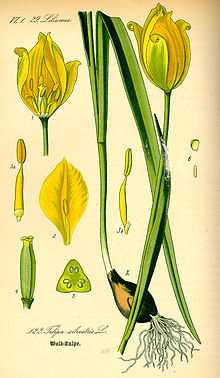Species of flowering plant
Tulipa sylvestris
1885 illustration[ 1]
Scientific classification
Kingdom:
Plantae
Clade :
Tracheophytes
Clade :
Angiosperms
Clade :
Monocots
Order:
Liliales
Family:
Liliaceae
Subfamily:
Lilioideae
Tribe:
Lilieae
Genus:
Tulipa
Subgenus:
Tulipa subg. Eriostemones
Species:
T. sylvestris
Binomial name
Tulipa sylvestris
Synonyms [ 2]
Liriopogon sylvestre (L. ) Raf.
Tulipa turcica Roth
Tulipa gallica Delaun. ex Loisel.
Tulipa aurea Raf.
Tulipa grisebachiana Pant.
Tulipa florentina Baker
Tulipa marshalliana Andrz. ex Baker
Tulipa grisebachii Borbás
Tulipa balcanica Velen.
Lilium bononiense E.H.L.Krause.
Tulipa abatinoi Borzí & Mattei
Tulipa grandiflora Hy
Tulipa primulina Baker, syn of subsp. primulina
Tulipa cuspidata Regel, syn of subsp. primulina
Tulipa elwesii Regel, syn of subsp. primulina
Tulipa australis Link, syn of subsp. australis
Tulipa pumila Moench, syn of subsp. australis
Tulipa celsiana Redouté, syn of subsp. australis
Tulipa transtagana Brot., syn of subsp. australis
Tulipa maculata Roth, syn of subsp. australis
Tulipa biebersteiniana Schult. & Schult.f., syn of subsp. australis
Tulipa patens C.Agardh, syn of subsp. australis
Tulipa tricolor Ledeb., syn of subsp. australis
Liriopogon celsianum (Redouté) Raf., syn of subsp. australis
Tulipa sibirica Patrin ex Kunth, syn of subsp. australis
Tulipa thirkeana K.Koch, syn of subsp. australis
Tulipa fragrans Munby, syn of subsp. australis
Tulipa alpestris Jord. & Fourr., syn of subsp. australis
Tulipa microgyna Baker, syn of subsp. australis
Tulipa caucasica Orph. ex Nyman, syn of subsp. australis
Tulipa callieri Halácsy & Levier, syn of subsp. australis
Tulipa bessarabica Zapal., syn of subsp. australis
Tulipa tchitounyi Azn., syn of subsp. australis
Tulipa tenuiscapa Pomel ex Batt., syn of subsp. australis
Tulipa paschalis Sennen, syn of subsp. australis
Tulipa hypanica Klokov & Zoz, syn of subsp. australis
Tulipa ophiophylla Klokov & Zoz, syn of subsp. australis
Tulipa quercetorum Klokov & Zoz, syn of subsp. australis
Tulipa samarica Klokov & Zoz, syn of subsp. australis
Tulipa sareptana Klokov & Zoz., syn of subsp. australis
Tulipa scythica Klokov & Zoz, syn of subsp. australis
Tulipa talijevii Klokov & Zoz, syn of subsp. australis
Tulipa valerii Zoz & Klokov, syn of subsp. australis
Tulipa graniticola (Klokov & Zoz) Klokov, syn of subsp. australis
Tulipa riparia Knjaz., Kulikov & E.G.Philippov, syn of subsp. australis
plus numerous other names at the level of subspecies, variety, or form
Tulipa sylvestris - MHNT Tulipa sylvestris wild tulip [ 3] woodland tulip ,[ 4] Eurasian and North African species of wild tulip , a plant in the lily family . Its native range extends from Portugal and Morocco to western China , covering most of the Mediterranean and Black Sea Basins, and Central Asia . The species is also cultivated as an ornamental and naturalized in central and northern Europe as well as a few scattered locations in North America .[ 2] [ 5] [ 6]
Description
Tulipa sylvestris It is a bulb-forming perennial, with narrow blue-grey leaves and usually with 1 or 2 flowers per stem.[ 6] [ 6] [ 7] [ 8] [ 9] [ 10]
They rarely produce seed and are pollinated by small insects.[ 6]
Biochemicals
Some tuliposides - a family of biochemicals -found in Tulipa sylvestris include:[ 11]
6-tuliposide A and B
Tuliposide D
Tulipalin A and B
Subspecies
Source: Plants of the World Online[ 2]
Tulipa australis is also found on the island of Malta , in the Mediterranean Sea , limited to one specific area.[ 12]
Habitat
It is found in dry grassy places and in woodland copses.[ 6]
References
^ illustration from Prof. Dr. Otto Wilhelm Thomé Flora von Deutschland, Österreich und der Schweiz 1885, Gera, Germany
^ a b c "World Checklist of Selected Plant Families: Royal Botanic Gardens, Kew" . apps.kew.org. Retrieved 2015-05-02 .^ NRCS . "Tulipa sylvestris " . PLANTS Database . United States Department of Agriculture (USDA). Retrieved 12 December 2015 .^ "Perennial Meadows, Design & Plant, Tulipa sylvestris – the woodland tulip" . perennialmeadows.com. 16 May 2013. Retrieved 2015-05-02 .^ "Plants Profile for Tulipa sylvestris (wild tulip) | United States Department of Agriculture plants profile" . plants.usda.gov. Retrieved 2015-05-02 .^ a b c d e Spencer-Jones, Rae; Cuttle, Sarah (2005). Wild Flowers of Britain and Ireland . London: Kyle Cathie Limited. p. 80. ISBN 9781856265034 ^ "Altervista Flora Italiana, Tulipano selvatico, Tulipa australis Link" . luirig.altervista.org. Retrieved 2015-05-02 .^ "Biota of North America Program 2014 county distribution map" . bonap.net. Retrieved 2015-05-02 .^ Everett, D. (2013). The genus Tulipa Tulips of the world: 1-380. Kew publishing, Kew.
^ Christenhusz, M.J.M., Govaerts, R., David, J.C., Hall, T., Borland, K., Roberts, P.S., Tuomisto, A., Buerki, S., Chase, M.W. & Fay, M.F. (2013). Tiptoe through the tulips - cultural history, molecular phylogenetics and classification of Tulipa (Liliaceae). Botanical Journal of the Linnean Society 172: 280-328.
^ Christensen, L (August 1999). "Tuliposides from Tulipa sylvestris and T. turkestanica" . Phytochemistry . 51 (8): 969– 974. Bibcode :1999PChem..51..969C . doi :10.1016/s0031-9422(98)00716-x . ISSN 0031-9422 . ^ Schembri, Patrick J.; Baldacchino, Alfred E. (2011). Ilma, Blat u Hajja: Is-Sisien tal-Ambjent Naturali Malti ISBN 978-99909-44-48-8
External links


